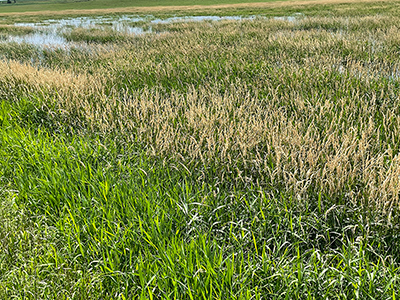Forage assessment and recovery following flooding
7/11/24
AMES, Iowa – Iowa has had a wide range of Iowa weather in the past few weeks, with areas of extreme flooding in the northwest part of the state. As the waters begin to recede, there are many considerations people are making. Iowa State University extension forage specialist Shelby Gruss said that when it comes to forage there are some steps producers should take to evaluate the damage.
"Damage may vary depending on how long the forage was submerged, the species, and the amount of sediment deposits," she said. "It is essential to document and report damages."
It has been announced producers impacted by the flooding will be eligible for Emergency Assistance for Livestock, Honeybees, and Farm-Raised Fish Program (ELAP) for feed and grazing losses. Baled hay and/or purchased hay losses can be covered under ELAP. However, the program will not cover hay that was cut and, on the ground, or hay that has yet to be harvested. Once you can assess the damage contact your local FSA office.
She said it's important for producers to evaluate their pastures as soon as possible to assess damage, debris, and silt deposits, and to continue monitoring the recovery of forage stands in the following weeks.
Gruss offered these recommendations for assessing conditions of pastures, hayfields and stored forages, and planning for possible next steps for forages:
Pasture health
First, walk through pastures to clear any debris that could be dangerous to livestock. Inspect and repair fencing and water systems. Ensure you have clean water before allowing animals back on the pastures.
Animal health considerations include ash content and microbe contamination on forage. Do not allow animals back on pastures for at least a couple of weeks to prevent microbial contamination. Floodwaters may have carried contaminants from sewage treatment plants, manure piles, potentially liquid manure holding ponds, and other contaminations onto you forage. Delaying turnout will allow the microbe populations to diminish and, it will give time for the pasture to dry out some to avoid pugging up the pasture.
Sediment deposits can be a large concern that can cause damage to the stands and, if grazed too early, could be detrimental to the health of your livestock. Sand and silt deposited on the plants will increase the ash content of the forage. Increased ash content on the forage can impact livestock performance. Although horses are particularly susceptible to sand, some extra steps may be needed to ensure the health of the horses.
Forage species survival will depend on a few factors, flooding length of time, how much of the plant was submerged, sediment deposits, and species. Many of our perennial forages can withstand flooding for up to a few days to weeks; with water receding now, many could recover. Stand assessments should be completed. Conduct stand assessments to check for root damage; dark-colored, mushy, and water-soaked roots are unlikely to recover. Examine for regrowth from crowns and tillers. Some of our legumes, particularly alfalfa, are susceptible to flooding, and damage to the stand can occur quickly.
Sediment deposited on the stands does not only potentially affect animals but also stand survival. Sediment deposit of more than two inches can smother the plants, leading to stand losses, and mechanical removal will help reduce stand losses. Perennial forage plants can typically produce new growth with less than two inches of deposit, but be sure to check for crusting. Crusting inhibits plant regrowth, and light tillage can help stimulate regrowth.
Alfalfa hayfields
Checking alfalfa damage should occur approximately a month after flooding. Alfalfa would be of large concern as it does not tolerate flooding for very long, and our alfalfa fields could have sustained substantial damage. Check the alfalfa roots six inches deep, and look for browning, soft roots, water-soaked appearance, or rotted-off roots. These are symptoms of root rot, such as phytophthora root rot, which may necessitate replanting the stand.
Silt deposits in alfalfa fields will cause similar problems as in pastures. Large amounts of silt deposits (2-3 inches) can weaken the stand, and these areas may need to be reestablished. However, be aware of reestablishing stands that are older than a year due to autotoxicity.
Stored Forage
Pastures and hayfields are not the only forages that can be affected. Stored forage, hay, and silage can be impacted as well. All stored feed impacted by the flood can be contaminated with sand, silt, and microbe populations. Dry bales in flooded areas greater than one foot for longer than a day should be disposed of. Hay exposed to less than one foot of flooding may have areas that are still safe to feed. Hay kept in barns that were flooded should be removed immediately to avoid heating and spontaneous combustion. Individual wrapped sealed bales may be safe to feed, but inline-wrapped bales with open ends may be affected throughout the line and must be assessed for damage and visible silt. For silage piles that have already undergone fermentation, assess the smell and color. Dispose of forage that is obviously contaminated with sediment or has off coloring and smell.
Be sure to document all losses, including the types and sizes of bales, for records and reports of losses.
What’s next: emergency forages and grazing
Delaying grazing allows for shoot regrowth and replenishment of carbohydrate reserves. For pastures with less than 70% damage, allow 1-2 months of recovery before grazing. Moderately damaged pastures, where 40-70% stand is still healthy, may require 2-3 months to recover fully. Additionally, weed management may be needed. Stand that acquired more significant damage should be considered for stand renovation to replant and could take up to a year for recovery.
There is still time to plant other forage options. For more details, refer to the article “Forage Options with Prevented Planting Fields.” Talk with your FSA agent about any replant restrictions. ISU extension beef specialists and field agronomists are ready to assist with your questions and concerns.
- See these resources for more information.
- Flood Damage and Recovery Management for Forages by John Jennings, Kenny Simon, Shane Gadberry, Ed Twidwell, Mike Andrews, Jennifer Caraway, Hank Chaney, Blair Griffin, and Kevin Lawson. University of Arkansas System Division of Agriculture Research and Extension.
- Step Two in Flood Recovery of Pastures Is Renovation by Beth Doran, Joel DeJong, and Brian Lang. Iowa State University Extension. ICM Blog 2019.
- Dealing with Pasture, Hay, Feed, and Livestock Losses After Significant Weather Events by Jennifer Tucker, Dennis Hancock, Lawton Stewart. 2019. University of Georgia Extension.
- Reclaiming Flood-damaged Pastures and Forage Production by Daren Redfearn, and Ben Beckman. 2019. University of Nebraska Lincoln.
-30-
The Iowa Beef Center at Iowa State University was established in 1996 with the goal of supporting the growth and vitality of the state’s beef cattle industry. It comprises faculty and staff from Iowa State University Extension and Outreach, College of Agriculture and Life Sciences and College of Veterinary Medicine, and works to develop and deliver the latest research-based information regarding the beef cattle industry. For more information about IBC, visit www.iowabeefcenter.org.
Contact:
Shelby Gruss, ISU extension forage specialist, 515-294-3832, sgruss@iastate.edu


